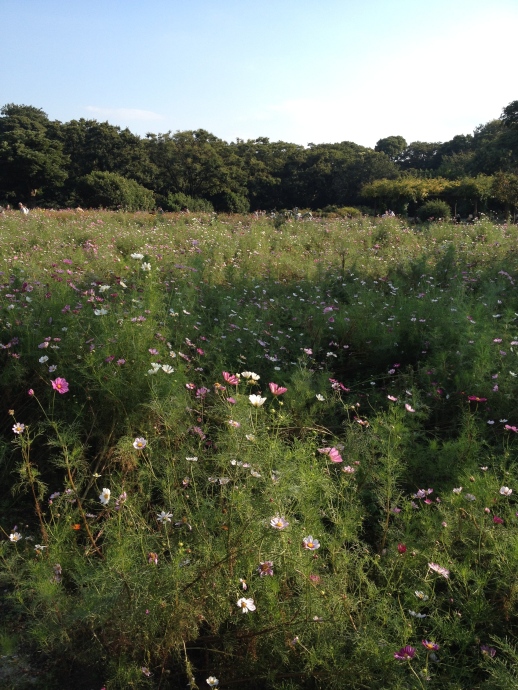Words and picture by Emma Warren.
It’s a warm and windy morning at the start of the month and I’m woken up by a gaggle of tiny, badger-headed birds in the plum tree outside my bedroom window. This sounds much more pastoral than the reality, which is that I live in a flat on the edge of Lewisham. The birds are swooping and calling to each other like they’ve flown straight out of a Disney film. I quickly identify them on the internet: they’re Long Tailed Tits and they’re ace.
I carve out half an hour at Oxleas later that afternoon in between finishing work and packing for a trip to Japan that will take me out of the country for nearly a month. I decide to walk around the margins of the meadow that sits like a connector between three parcels of Oxleas’ woodland. It’ll be enough to get a sense of what’s going on and anyway, the margins are always where the most interesting things happen. This is as true for culture as it is for nature, although it occurs to me that in essence, there’s not a lot of difference between the two. Culture follows the same rules as nature: new ideas grow on the leaf-litter of previous ideas. Both require life to generate life.
I’ve only been in the woods ten minutes when I see a woodpecker. Or is a treecreeper? I see flashes of a small, pinkish body as it runs underneath branches like a birdy cartoon. Then I hear them again, tscharp tscharp tscharp! It’s the Long Tailed Tits, larking about in low branches, emitting their lovely synthesiser song. The RSPB describe them as ‘gregarious’ and the really are. I almost expect one to come and lift my coat up for a laugh.
The hedgerow here is made up of bramble and hazel and a fat patch of Butchers Broom and the entirety is thinning. Autumn is a season of apparent recession, of gaps and re-opened views. If spring is defined by an upward thrust then autumn is the opposite, a calling back, a dropping, a falling inward: seasonal gravity.
A jay flies out of the woods and then almost as quickly pings back into the safety of the branches like it’s on elastic. Something pink and hawk-ish takes off out of the scrap of ancient hedgerow that bisects the meadow. It flies up and to the left, over Jackwood, circles the tree tops and hangs in the air like a child’s kite, a silhouette. It becomes a negative, a bird-shape cut out of the sky, at least until it propels itself back to the fat-trunked hedgerow which is being turned scrappy as the season circles into the apparent stillness of winter.
I’m still thinking about Oxleas when I arrive in Tokyo and see the city’s jungle crows skeeting around the neon towers of Shibuya. These creatures are larger than their European cousins, with a fat, brutal bill and a hoarse, echoic caw. They are as much the sound of the city as the zebra crossings that mimic computer games or the high-pitched women’s voices that trill, courteously, from huge LCD billboards. Tokyo’s jungle crows are extremely resourceful: with little in the way of twigs and branches in this most built-up of cities, they’ve been known to make nests with coat hangers. They’re one of those creatures you imagine would breeze through the apocalypse.
I’ve been in the city a week when I feel the need for a nature hit to balance out all the speaker stacks and 4am ramen, so on my first weekend off I walk an hour east towards Tokyo Bay. I’m heading for Hamarikyu Gardens, a park that started out as a duck hunting ground and falconry site for Shogun families and that opened to the public in 1946. It’s edged by Tokyo Bay on one side and by the smoggy expressways and vast offices of Shiodome.
It’s exceptionally pretty without being twee. The wooded areas are deep green tunnels with soft corners and gentle rocky outcrops. Herons and cormorants potter quietly around their pond island, sitting on rocks in the reflection of multi-storey office buildings. There’s a 300-year-old black pine ranged out over gentle struts and careful supports that miraculously survived World War II firebombing. Even the huge spread of pink and white peonies waving unlocked in the breeze suggest freedom rather than formality – there are no gates or fences separating them from us.
The crows are still hanging in the sky but they’re softened in the soundscape by crickets and waterbirds. There are fat duck sounds, rounded out by pygmy woodpeckers and the trinket sounds of songbirds I can’t see. It’s pastoral bliss, surrounded by skyscrapers, like Oxleas if it were sat right next to The Shard.
